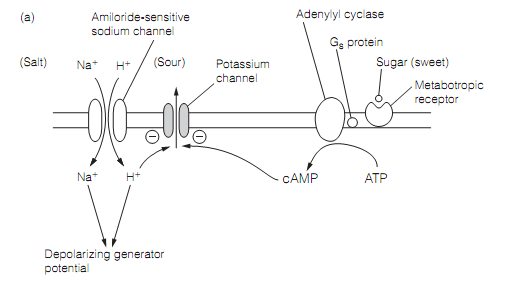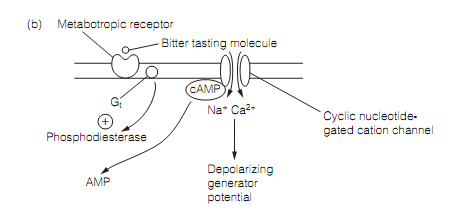Taste transduction
Most of the ions or molecules responsible for taste sensation are hydrophilic and freely diffusible. Those which are hydrophobic involve plant alkaloids that may bind to proteins in the saliva, equal to odorant-binding proteins, for appearance to gustatory receptor cells. Transduction includes changes in membrane conductance that causes a depolarizing generator potential, triggering action potentials and discharge of neurotransmitter that excites the gustatory primary afferents.
Salt taste is caused by Na+ ions. Salt transduction is as shown in figure (a) takes place by the influx of Na+ via an amiloride-sensitive Na+ channel.

Figure: sour, salt, and sweet transduction mechanisms, note that an amiloride-sensitive Na+ channel is implicated in both salt & sour taste
H+ ions responsible for sour sensation causes a generator potential by blocking voltage-dependent K+ channels in the apical membrane that at rest bring an outward, hyperpolarizing current.Sugars, a few amino acids and several proteins generate sweet sensations by interacting with G-protein-linked receptors coupled to second messenger. The sugar activates adenylyl cyclase and the resulting rise in cAMP generates depolarization by closing a K+ channel. Few compounds responsible for sweetness (example, artificial sweeteners) increase inositol trisphosphate (IP3) levels and mobilize Ca2+ in receptor cells.Multiple pathways mediate bitter taste transduction as shown in figure (b). This reflects the broad diversity of molecules which are bitter flavored. Divalent salts and quinine block K+ channels and therefore depolarize by decreasing outward potassium current. In a method with striking parallels to phototransduction, few bitter tasting agents bind metabotropic receptors coupled to transducin (Gt) activating a phosphodiesterase which hydrolyzes cAMP. The fall in cAMP concentration causes cAMP to dissociate from a cyclic-nucleotide-gated (CNG) cation conductance, permitting influx of Na+ and Ca2+ and hence depolarization.

Figure: one of several mechanisms included in bitter transduction.
The umami taste sensation generated by l-glutamate seems to include metabotropic glutamate (mGluR4) receptors coupled through Gi proteins to the inhibition of adenylyl cyclase.